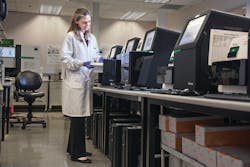In the late 1940s, Mandel and Metais described the presence of circulating cell-free DNA (cfDNA) in the blood stream.1 The discovery that a fraction of that cfDNA can originate from a tumor spawned a movement to develop laboratory methods to identify this material to aid screening and diagnosis of cancer.2
More than a half century later, that movement has culminated in the use of circulating tumor DNA (ctDNA) as a “liquid biopsy.” Liquid biopsy is defined by the National Cancer Institute as, “a test done on a sample of blood to look for cancer cells from a tumor that are circulating in the blood or for pieces of DNA from tumor cells that are in the blood” assayed for biomarkers specific to cancer.3
The capability to sequence a patient’s tumor DNA from a peripheral blood draw has been the focus of much discussion and debate among the scientific and medical community in recent years. It has also generated businesses seeking to use liquid biopsy tests in clinical studies or as commercial tests. Today, well over 300 clinical trials are investigating liquid biopsy utility, and several commercial vendors have launched liquid biopsy assays. Indeed, the $310 million liquid biopsy market from 2016 is predicted to increase to a staggering $1.2 billion by 2023.4
Liquid biopsy presents the potential for a leap forward in the clinical management of patients with advanced solid tumor cancers and potentially other diseases. However, a gap in knowledge exists regarding aspects of tumor biology, technological optimization, and the clinical utility of using these assays to screen for disease, monitor and quantify disease burden, predict response, and select for targeted therapies and immunotherapies. As further biological knowledge and clinical evidence emerges from the studies and clinical trials surrounding liquid biopsy as a diagnostic or screening test, the potential clinical applications of ctDNA should become clear.
Researchers are endeavoring to better understand the biological origin of cfDNA/ctDNA and its physiological and pathological characteristics, for they have the potential to impact the clinical utilization of liquid biopsy. Healthy individuals have cfDNA circulating in the bloodstream originating from active secretion by or apoptosis/necrosis from hematopoietic cells in circulation. These DNA fragments are on average ~167bp in length, corresponding to the length of DNA associated with the nucleosome-histone complex, and the amount of this cfDNA varies among individuals.1,5 In cancer patients, ctDNA molecules are shorter and comprise only a small fraction of the overall cfDNA.1,5 Though cfDNA can be detected in different bodily fluids, ctDNA isolated from plasma in the blood has been the most widely studied and blood testing is therefore the favored method of today’s commercialization efforts.
Further, the quantity of ctDNA in circulation is proportional to the tumor burden related to both size and stage. However, variations in ctDNA differ among individuals that impact the utility of liquid biopsy, and these differences can arise from vascularization, histological factors, and shedding rates of the tumors.1 The low abundance of ctDNA in general poses a challenge in detection of mutant alleles, especially those near one percent variant allele frequency or lower. Studies have shown mutation fractional abundance peaks around 0.2 to 1.0 percent for ctDNA compared to the 25 to 50 percent peak in tissue.6 To overcome the intrinsic biological nature of ctDNA, detection of mutant alleles requires highly sensitive and specific assays to match the clinical utility of tissue biopsies, the current recommended standard for diagnosis and subsequent therapeutic decision-making.
Tissue biopsy vs. liquid biopsy
Tissue biopsy is of course the standard of care for solid tumor diagnosis. Well understood and validated, this type of testing provides a far higher degree of accuracy, based on current evidence, than today’s clinically available liquid biopsy techniques.
Yet, tissue biopsy has several disadvantages the liquid biopsy ideally would surmount. These include complications arising from the invasive biopsy procedure, such as bleeding and infection; tumor tissue inadequacy or inaccessibility; turnaround time; and sampling biases due to a genetic heterogeneity within the primary tumor and between primary and metastatic tumor sites. Other concerns include the need for repeat biopsies, the preservation of tumor tissue that can affect downstream molecular analysis, and the fragility of the patient.
Plasma-based liquid biopsy in theory can eliminate these issues by allowing expedited access to the entire mutational profile of both the primary tumor and metastatic sites. This analysis would provide a simultaneous snapshot of all potential cancerous lesions, eliminating the need for invasive procedures to obtain tissue and the clinical risks associated with it. Further, liquid biopsies could potentially be more cost-effective and time-efficient tests. These benefits must be weighed against limitations including relatively low clinical sensitivity and specificity compared to tissue testing, the inability to detect phenotypic transitions in tumor type, and the lack of consistent thresholds and reporting guidelines.5
Current approaches to liquid biopsy include digital PCR and real-time PCR for candidate gene analysis and next generation sequencing applications for multiplexing capability. These technologies used for liquid biopsy assays claim analytical sensitivities of less than one percent with a collective clinical sensitivity of ~70 percent, but this sensitivity increases with increasing tumor burden.5 It is imperative to have technologies that are highly sensitive and specific, reliable, and technically straightforward with the ability to multiplex.
Commercial liquid biopsy tests
Several organizations have brought lab developed and in vitro diagnostic liquid biopsies to market. The Cobas EGFR Mutation Test v2 from Roche Diagnostics was the first FDA-approved liquid biopsy for cancer therapy selection. This PCR-based assay is designed to identify specific EGFR mutations in patients with non-small cell lung cancer (NSCLC), the most common form of lung cancer, at diagnosis or progression that would confer sensitivity or resistance to erlotinib, gefitinib, or osimertinib. Lab-developed tests that interrogate multiple genes and genomic abnormalities in multiple tumor types may be an attractive option for physicians due to their broader gene content and the additional information about on-label and off-label drugs and clinical trial information provided in the report. Many companies with larger panels are currently working toward FDA approval or clearance of their assays to show clinical validity and utility and improve coverage and reimbursement from health plans.
Current National Comprehensive Cancer Network (NCCN) and CAP/IASLC/AMP testing guidelines recommend liquid biopsy in the setting of advanced NSCLC in cases with limited tissue availability or in those patients unfit to undergo a tissue biopsy.7,8 In the event of negative liquid biopsy result, guidelines recommend tissue-based testing. Clinical use must be limited, and caution must be taken to ensure this type of testing is performed on the correct population of patients. Currently, clinical utility lies in testing for advanced stage cancers rather than early stage cancers. The oncology community still needs to further the understanding of the biology and limitations of cfDNA testing, when to apply the test, and what the results truly mean before liquid biopsy can be more broadly applied.
Recent studies have indicated a lack of concordance between different vendors’ liquid biopsy assays with high variability in sensitivity and positive predictive value due to heterogeneity, clonal hematopoiesis, and technical factors including pre-analytical and analytical differences between methodologies.9 Such pre-analytical factors that influence levels of cfDNA include collection tube type, blood processing procedures, and nucleic acid extraction methods.2
Further, analytical factors including library design, sequencing technologies, and bioinformatics play a significant role in the sensitivity and specificity of the test.2 False positives and false negatives can be associated with biological factors like tumor heterogeneity and germline variants or benign clonal hematopoiesis that increase background noise and influence bioinformatic algorithms regarding filtration of germline variants.
These factors underscore the need for standardization around liquid biopsy analytical performance, workflows and technologies, and specified guidelines must be in place for widespread adoption by the community.
Reimbursement challenges
To further complicate widespread adoption of liquid biopsy, health plan coverage and reimbursement for liquid biopsy assays remains quite narrow. The Molecular Diagnostics Services Program (MolDx) only recently approved the use of liquid biopsies in patients with advanced NSCLC who are unable to have tissue testing performed for therapy selection.10 Further, MolDx has recently published a draft local coverage determination for one lab’s liquid biopsy assay that would expand the inclusion criteria to 12 solid tumor cancer types but in keeping with the advanced cancer population who cannot undergo tissue testing.11
Private payers have been much more reluctant to cover multiple gene panel liquid biopsies as many deem them investigational or experimental until greater clinical utility has been established. Some have adopted a similar policy to the Centers for Medicare and Medicaid Services (CMS) in the case of advanced NSCLC, as described above, but those are not in the majority.
However, many laboratory services that were once deemed investigational are now mainstream and widely covered by health plans. The landscape of liquid biopsy is evolving, and the number of ongoing clinical trials to investigate the clinical utility of liquid biopsy testing may cause a shift to broader coverage of blood-based testing in the coming years.
Cautiously optimistic on liquid biopsy
It would be prudent to proceed with cautious optimism as we learn more about applications and limitations of liquid biopsy in oncology care. Investigations and clinical trials are ongoing into the utilization of this technology for early diagnosis, treatment response and recurrence monitoring, evaluation of clonal evolution and resistance, and even as a screening tool to help detect cancers early.
For now, liquid biopsy applications need to stay within the intended use population of advanced cancers when tissue is not available, and the results need to be used in conjunction with other clinical data from imaging and tissue biopsies. For all the potential in liquid biopsy diagnostics, tissue will remain at the core of cancer diagnosis, prognostication, and therapy selection for now.
REFERENCES
- Wan JCM, et al. Liquid biopsies come of age: towards implementation of circulating tumor DNA. Nat Rev Cancer. 2017 Apr; 17(4):223-232.
- Dominguez-Vigil IG,. et al. The dawn of the liquid biopsy in the fight against cancer. Oncotarget. 2017 Dec 8;9(2):2912-2922.
- NCI Dictionary of Cancer Terms. National Cancer Institute. https://www.cancer.gov/publications/dictionaries/cancer-terms/def/liquid-biopsy. Published 2019. Accessed April 15, 2019.
- Statistics Market Research Consulting, “Liquid biopsy – global market outlook (2017-2023)” 2017. Available at: https://bit.ly/2SmkGW2. Accessed April 15, 2019.
- Lynette M. Sholl. October 9, 2018. Liquid Biopsies – Promises and Pitfalls. [Webinar]. In Advancing Patient Care in NSCLC: Breaking Down Barriers. Retrieved from http://educate.amp.org/store/seminar/seminar.php?seminar=135840
- Muller JN, et al. Concordance between comprehensive cancer genome profiling in plasma and tumor specimens. J Thorac Oncol. 2017 Oct;12(10):1503-1511.
- National Comprehensive Cancer Network. (2019). Non-Small Cell Lung Cancer (Version 3.2019 – January 18, 2019). Retrieved from https://www.nccn.org/professionals/physician_gls/pdf/nscl.pdf
- Lindeman NI, et al. 2018. Updated molecular testing guideline for the selection of lung cancer patients for treatment with targeted tyrosine kinase inhibitors. J Thorac Oncol. 2018 Mar;13(3):323-358.
- Stetson D, et al. Orthogonal comparison of four plasma NGS tests with tumor suggests technical factors are a major source of assay discordance. JCO Precison Oncology 2019 3:1-9.
- CMS.gov. MolDX: Guardant360 Plasma-Based Comprehensive Genomic Profiling in Non-Small Cell Lung Cancer (NSCLC). 8/27/18. 3/29/19.
- CMS.gov. MolDX: Guardant360 Plasma-Based Comprehensive Genomic Profiling in Solid Tumors. 3/28/19. 3/29/19.
About the Author

Nathan McNeill, PhD
serves as Director of Molecular Assay Development and a Medical Science Liaison at MedFusion, a Quest Diagnostics company. He has extensive experience in human genetics and molecular diagnostics with over 10 years of research experience.

Greg Baschkopf
serves as Product Director for Solid Tumor Profiling at Quest Diagnostics. He has more than 10 years of experience in the molecular diagnostic lab industry. His career began in the lab and he has held positions in sales, training and product management.
